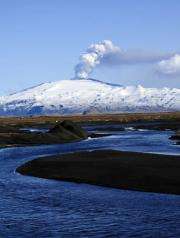Iceland ash emissions at 'insignificant' level: expert

Only an "insignificant" amount of ash is erupting from Iceland's Eyjafjoell volcano, one of the country's leading seismologists said Wednesday, as European skies finally began to clear, allowing air traffic to resume.
"Explosive activity has diminished. Ash production has gone down. It's really insignificant right now," Pall Einarsson, from Iceland's Institute of Earth Sciences, told journalists at the government's Civil Protection Agency.
Sigurdur Gislason, also from the Institute of Earth Sciences, said: "There is much, much less ash."
Einarsson stressed, however, that the volcano continues to erupt and is unpredictable. It has "not gone to sleep", he said.
The clearer skies were good news for passengers stranded in airports around the world after a week when ash from the volcano made European airspace too dangerous for jet planes to fly, bringing the continent's travel industry to a halt.
Gudrun Nina Petersen at the Icelandic Meterological Office said the ash plume from Eyjafjoell was "very low" and no longer spewing into altitudes used by aircraft.
"We don't expect any significant amount of ash above flight level," she said.
Surface winds, currently blowing the smoke towards the southeast and Europe, should change direction during the day to blow southwest into the Atlantic, said Ingveldur Thordardottir at the Civil Protection Agency.
However, scientists cautioned that the powerful, high-altitude jet stream continues to blow over Iceland into continental Europe, meaning that there is still the potential for carrying ash southeast.
Einarsson underlined that the volcano, while producing visibly less debris, is still very much alive.
"Seismic tremors are as high as ever," he said. "We don't see any sign of it ending and can't predict when it will end. Some people will give you an answer, but if they answer it, it is wrong."
Government scientists are trying to calm widespread fears that the far bigger neighboring volcano, called Katla, could go off next.
Historically there appears to be a relationship between the two volcanoes, although scientists say there is no direct link. Katla last erupted in 1918.
Iceland's President Olafur Ragnar Grimsson caused a stir earlier this week when he said in a BBC interview that the current eruption was a "small rehearsal" for Katla.
Einarsson said the "fierce and rather dangerous" Katla was a worry, but that there was no sign of imminent danger.
"Eyjafjoell and Katla sometimes seem to act in tandem," he said. There's not any certainty in this, but that is what history tells us."
Geophysicist Sigrun Hreinsdottir, at the Earth Sciences Institute, said measuring instruments around Katla showed no sign of movement.
"Right now we don't see anything," she said. "We are monitoring it very carefully."
The lull in the crisis finally brought relief to the airline industry and huge numbers of travellers.
Three-quarters of flights scheduled in Europe were expected to be completed, said the body coordinating air traffic across the continent, and air traffic was expected to return almost to normal on Thursday.
The airline industry estimates its losses from being forced to ground aircraft at 1.7 billion dollars (1.3 billion euros).
(c) 2010 AFP


















